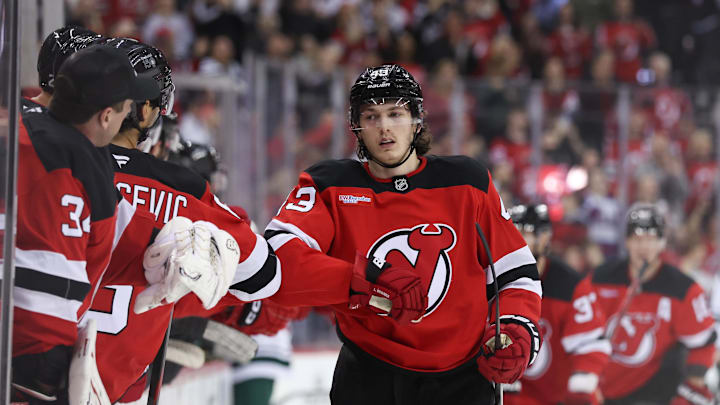With the offseason underway, the New Jersey Devils face critical decisions that will shape the next phase of their competitive window. While adding depth scoring remains a clear focus, the direction of the team hinges on two foundational moves: the extension of Luke Hughes and the hiring of Brad Shaw as assistant coach. These developments are intertwined—not just symbolically, but strategically—and could represent a turning point for how the Devils define themselves both on the ice and within the salary cap.
Luke Hughes is fresh off an impressive campaign that saw him flash elite puck-moving skills, creativity in transition, and offensive instincts rare for a young defenseman. At just 21 years old, he already looks like a long-term fixture on New Jersey’s top pairing. That makes his next contract all the more important—not just for what it means financially, but for how it sets up the rest of the roster in the coming years.
There’s growing momentum around the idea of mirroring Jack Hughes’ contract. Jack’s eight-year, $64 million deal ($8M AAV) has aged gracefully, especially as the salary cap rises. For Luke, a comparable six-year, $45 million extension (with a front-loaded structure of $6.5M AAV for years 1–3 and $8.5M AAV in years 4–6) would carry an average annual value of $7.5 million. It would buy up a few UFA years, give the Devils cost certainty, and offer him both stability and long-term buy-in, aligning his term with the core group that includes Jack Hughes, Nico Hischier, and Jesper Bratt.
On paper, it makes sense. With the salary cap expected to hit $95.5 million, locking in a top-pairing defenseman at $7.5M could end up being a bargain within two seasons. But this route also limits short-term flexibility. Committing to that number now would tighten space needed to upgrade the forward corps, especially in the bottom six, where production has lagged behind expectations.
That’s why a bridge deal—in the $6–7 million AAV range for two or three years—remains a legitimate option. It would preserve cap room for targeted acquisitions and give Hughes time to develop further before locking in his true market value. A bridge deal could include deferred salary components, offering more flexibility this offseason while giving him the chance to cash in bigger down the road.
But now, with Brad Shaw’s arrival, the entire equation shifts.
Shaw’s hiring was no afterthought. Known as one of the NHL’s most respected defensive tacticians, he brings over two decades of NHL coaching experience, with recent stints in Columbus, Vancouver, and Philadelphia. His systems emphasize structure, accountability, and high-effort zone reads, particularly in the defensive end. Where the Devils often faltered in 2024–25 was in their zone exits, neutral zone gaps, and coverage below the dots. These are exactly the areas where Shaw’s teams typically improve fast.
Tactically, Shaw favors layered support. Under his system, defensemen are required to close gaps early, read puck carriers with discipline, and control the middle of the ice. His approach blends man-on-man elements with zone principles depending on the opponent and situation. This hybrid structure demands IQ and effort from the entire five-man unit, not just the blueliners.
For Luke Hughes, this could be transformative. While his skating and offensive instincts are already NHL-caliber, his decision-making without the puck and positional awareness will benefit immensely from Shaw’s oversight. Hughes won’t be told to rein in his creativity—he’ll be taught how to time his involvement, read weak-side support, and pick his spots to jump into the rush without leaving his partner exposed. Shaw’s impact on Luke’s defensive game could be the bridge between “talented young player” and “elite two-way defenseman.”
And from a front office perspective, that development gives Tom Fitzgerald more confidence in investing big early. If the Devils believe Shaw will unlock the next level in Hughes’ game—especially in the defensive zone—then committing six years now is less of a gamble and more of a foundational statement.
Shaw’s influence goes beyond just Hughes. His presence will be critical for Simon Nemec, who is trending toward a full-time top-four role, and any younger defensemen trying to establish themselves. A structured system helps goalies like Nico Daws, as cleaner zone coverage reduces high-danger looks and eases rebound control issues.
But it circles back to Luke Hughes’s contract. Do the Devils lock him up long-term, betting that Shaw’s mentorship fast-tracks his development into a top-pair, two-zone defenseman? Or do they sign him short-term, keeping cap space open for scoring help while accepting the risk of a much pricier extension later?
It’s a calculated decision. Opting for the long-term Hughes deal would restrict spending elsewhere but solidify a core pillar. Choosing the bridge leaves room for depth signings and trade flexibility, but could backfire financially if Luke’s value spikes too quickly.
Then there’s the long-view wrinkle: if the Devils remain disciplined with their cap structure and internal development, it keeps open the possibility of adding Quinn Hughes down the road. If Vancouver falters and Hughes is entrenched in New Jersey with Simon Nemec and Shaw’s system in place, the door could open for a reunion—one that gives the Devils arguably the most dynamic blue line trio in the league.
Either way, Luke Hughes’ next contract and Brad Shaw’s defensive system are tied together. Both represent a shift in how the Devils are building—not just for talent, but for structure, consistency, and a playoff-caliber identity.
The Devils have the pieces. Now it’s about fitting them into a winning system, and it starts with Luke and the man who’ll help shape him from the bench.
